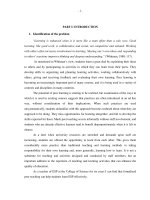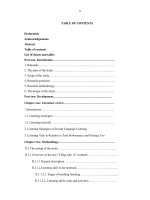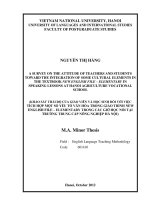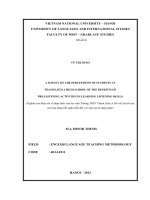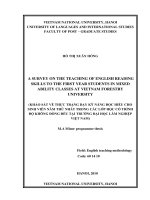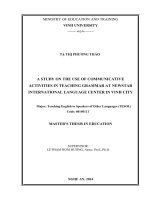A survey on the use of shadowing in learning english adopted by 2nd year english majors at vietnam national university of agriculture
Bạn đang xem bản rút gọn của tài liệu. Xem và tải ngay bản đầy đủ của tài liệu tại đây (899.78 KB, 44 trang )
VIET NAM NATIONAL UNIVERSITY OF AGRICULTURE
FACULTY OF EDUCATION AND FOREIGN LANGUAGES
BA THESIS
A SURVEY ON THE USE OF SHADOWING IN
LEARNING ENGLISH ADOPTED BY 2ND YEAR
ENGLISH MAJORS AT VIETNAM NATIONAL
UNIVERSITY OF AGRICULTURE
KHẢO SÁT VỀ VIỆC SỬ DỤNG SHADOWING TRONG
HỌC TIẾNG ANH CỦA SINH VIÊN NĂM HAI NGÀNH
NGÔN NGỮ ANH HỌC VIỆN NỒNG NGHIỆP
VIỆT NAM
Student
: Đinh Vũ Hoài Thu
Student code
: 621238
Major
: English Major
Supervisor
: Bùi Thị Là M.A
Hanoi – 2021
VIET NAM NATIONAL UNIVERSITY OF AGRICULTURE
FACULTY OF EDUCATION AND FOREIGN LANGUAGES
BA THESIS
A SURVEY ON THE USE OF SHADOWING IN
LEARNING ENGLISH ADOPTED BY 2ND YEAR
ENGLISH MAJORS AT VIETNAM NATIONAL
UNIVERSITY OF AGRICULTURE
KHẢO SÁT VỀ VIỆC SỬ DỤNG SHADOWING TRONG
HỌC TIẾNG ANH CỦA SINH VIÊN NĂM HAI NGÀNH
NGÔN NGỮ ANH HỌC VIỆN NỒNG NGHIỆP
VIỆT NAM
Student
: Đinh Vũ Hoài Thu
Student code : 621238
Major
: English Major
Supervisor
: Bùi Thị Là M.A
Hanoi – 2021
CERTIFICATE OF ORIGINALITY
I, the undersigned, hereby certify my authority of the study project report
entitled A SURVEY ON THE USE OF THE SHADOWING IN LEARNING
ENGLISH ADOPTED BY 2ND YEAR ENGLISH MAJORS AT VIETNAM
NATIONAL UNIVERSITY OF AGRICULTURE submitted in partial fulfillment
of the requirements for the degree of Bachelor in English Language. Except
where the reference is indicated, no other person’s work has been used without
due acknowledgement in the text of the thesis.
Hanoi, 2021
Đinh Vũ Hoài Thu
Approved by
SUPERVISOR
(Signature and full name)
Date:……………………
i
ACKNOWLEDGEMENTS
For the completion of this thesis, I have received great assistance and
support from many people without whom the work could not have been
fulfilled. First and foremost, I would like to express my sincere thanks to Ms.
Bui Thi La, my supervisor. This thesis could have probably not completed
without her patient, enthusiastic and instructive supervision and encouragement.
I also would like to show my profound gratitude to all the lecturers at Vietnam
national university of Agriculture, especially the lecturers in the Faculty of
Education and Foreign Languages for tirelessly devoting time and efforts to
enrich, broaden and deepen my knowledge over the past four years. My special
thanks go as well as to the Faculty of Education and Foreign Languages of
Vietnam national university of Agriculture for giving me the opportunity and
permission to implement this report. I am particularly grateful to the first-year
English majors coming from course 62 of Faculty of Education and Foreign
Languages, Vietnam national university of Agriculture who help me a lot in
completing the survey so that I can get the data for my research. I cannot help
fully expressing my gratitude to all people that direct and indirect support me to
accomplish my thesis in time. My thesis may still have many shortcomings. Last
but not least, I owe a debt of gratitude to my beloved family, for their wholehearted encouragement and endless support.
Thank you sincerely!
ii
TABLE OF CONTENTS
Certificate of originality ......................................................................................... i
Acknowledgements ............................................................................................... ii
Table of contents .................................................................................................. iii
List of tables ......................................................................................................... vi
PART 1: INTRODUCTION ................................................................................. 1
1.1. Rationale for the study ................................................................................... 1
1.2. Aims and objectives of the study ................................................................... 2
1.2.1. The aim of the study .................................................................................... 2
1.2.2. Objective ..................................................................................................... 2
1.3. Research questions ......................................................................................... 2
1.4. Scope of the study .......................................................................................... 2
1.5. Significance of the study ................................................................................ 2
1.6. Design of the study ......................................................................................... 3
Chapter 1: LITERATURE REVIEW .................................................................... 4
1.1. Review of previous studies ............................................................................ 4
1.1.1. Abroad ......................................................................................................... 4
1.1.2. At home ....................................................................................................... 5
1.2. Review of theoretical background ................................................................. 5
1.2.1. What is shadowing? .................................................................................... 5
1.2.4. Effectiveness of shadowing....................................................................... 12
Chapter 2: METHODOLOGY ............................................................................ 15
1. Research method ............................................................................................. 15
2. Research setting/context.................................................................................. 15
3. Data collection................................................................................................. 15
3.1. Data collecting instruments .......................................................................... 15
3.2. Data collecting procedures ........................................................................... 15
iii
4. Data analysis ................................................................................................... 16
5. Summary ......................................................................................................... 16
Chapter 3: FINDINGS AND DISCUSSION ...................................................... 17
3.1. Current situation of the use of shadowing technique to improve learning
English ................................................................................................................. 17
3.2. The condition in using shadowing activity of student in learning English .. 21
3.4. Summary ...................................................................................................... 26
PART 3: CONCLUSION .................................................................................... 28
1. Recapitulation.................................................................................................. 28
2. Concluding remarks ........................................................................................ 28
Reference ............................................................................................................. 32
Appendix 1 .......................................................................................................... 34
iv
ABSTRACT
Shadowing is not a new method of learning English but very few people
know and apply it to learn second language. Besides, there is also very little
research on this method. In this paper, the research analysis of this topic will
clarify the learning method and propose solutions to improve students' English
learning. We will be using theoretical research methods to analyze, synthesize,
compare and generalize theoretical and practical research results of researchers
on shadowing in order to draw out instrumental concepts. and theoretical
framework for the research topic. Investigation method to reflect the condition
in using shadowing technique of students. The survey focuses on understanding
the application of shadowing methods; preferences and difficulties faced by
students in applying the method. At the end,as the result, the study show current
situation of the use of shadowing technique to improve learning English among
English majors at VNUA and solutions to develop English skills of second-years
English majors.
Key word: Shadowing, the perception, the condition, method, solutions.
v
LIST OF TABLES
Table1. The shadowing process is based on Murphy's conversational reading
theory ..................................................................................................................... 7
Table 2. Shadowing Procedure of Katoda and Tamai (2004) ............................. 12
Table 3. Essentials use in shadowing .................................................................. 20
Table 4. Difficulties in using shadowing ............................................................ 25
Chart 1. 2nd year English major student’s English level .................................... 17
Chart 3. 2nd year English major students’ perception on shadowing definition 19
Chart 4. 2nd year English major students’ perception on shadowing effective . 20
Chart 5. 2nd year English major students' shadowing activity frequency .......... 21
Chart 6. Shadowing activities in self-study of 2nd year English major students'
reading skills........................................................................................................ 22
Chart 7. 2nd year English major students' conversation practice habits ............. 23
Chart 8. Shadowing activities in self-study of 2nd year English major students'
listening skills ...................................................................................................... 24
vi
PART 1: INTRODUCTION
1.1. Rationale for the study
“Shadowing” this is an extremely effective technique if you want to
improve your tune, tongue and pronunciation while learning a foreign language.
The definition of "Shadowing" is quite simple, learners just need to listen to a
sample video or audio with a real human voice and repeat what they say. Unlike
the technique of listening, stopping and repeating, you will not wait to hear the
whole sentence and then repeat what the Speaker said, but you and the Speaker
will say almost simultaneously. That is, you will completely imitate the way
they break sentences, emphasize, attach and avoid procrastination as much as
possible.
According to Clare Maas (2017), shadowing is a technique that language
learners try to speak at the same time with an audio text, like singing along with
a song (although sometimes there is a transcription in front of them). Therefore,
shadowing focuses on sounds, not words. Meaning is secondary in shadowing
tasks, as learners should imitate the sounds they hear, instead of trying to
understand what is being said. This technique, which is said to improve
pronunciation and listening skills, has been widely adopted in Asia.
The characteristic of shadowing is imitation that tends to be relevant to the
Vietnamese education because this educational culture is based on learn by
heart. However, in Vietnam, the number of studies on the application of this
technique in the classroom has not received much attention. Currently, there are
very few topics that study how learners apply the fixed phrases they come across
from reading comprehension into speaking and writing activities to convey
content from meaning-focused communicative. output) and steps to be taken to
enhance the transitions of these phrases from input information, the readings
input to output, the speech or output (Hoang & Boers, 2016 ).
1
Therefore, I chose the subject as my graduation thesis: “A survey on the
use of shadowing in learning English adopted by K64 English major at VNUA.”
1.2. Aims and objectives of the study
1.2.1. The aim of the study
The aim of the study is to investigate the use of shadowing on the process
of English learning and teaching
1.2.2. Objective
To study on the use of shadowing in learning English adopted by K64
English majors at VNUA.
Suggest solutions to improve English learning and teaching at VNUA.
1.3. Research questions
What is current situation of the use of shadowing technique to improve
learning English among English majors at VNUA?
What suggestions should be given to develop English skills of second-years
English majors?
1.4. Scope of the study
Studying on the use shadowing of English majors students, faculty of
Education and Foreign Language, Vietnam National University of Agriculture.
The study begins on 01/03/2021 and finish on 30/06/2021.
1.5. Significance of the study
The results of the study provide insights into the use of shadowing
techniques in English learning by second-year English majors students. In
addition, there are solutions given to improve skills and apply methods to
learning a second language.
2
1.6. Design of the study
PART 1 - INTRODUCTION presents the rationale of the study, aims and
objectives of the study, research questions, the scope as well as the significance
of the study.
PART 2 - DEVELOPMENT is divided into 3 chapters:
Chapter 1 - LITERATURE REVIEW – provides theoretical background for
the study including definition of listening, types of listening, factors affecting
English listening skills, suggested in-class activities, and listening activities
outside the classroom
Chapter 2 – METHODOLOGY describes the methodology used in the
research including the research methods, research setting/ context, data
collection, and data analysis.
Chapter 3 - FINDINGS AND DISCUSSIONS - reports and discusses the
findings of the study.
PART 3 - CONCLUSION summarizes the main issues that have been
addressed in the study, points out the limitations, draws pedagogical
implications concerning the research topic and recommends several listening
activities to English-majored students at VNUA.
3
PART 2: DEVELOPMENT
Chapter 1: LITERATURE REVIEW
1.1. Review of previous studies
1.1.1. Abroad
Shadowing not an extraordinary technique with English learner in the
world however research about this technique still have tiny. But by effort and
hard work, I find some research about it:
Shadowing is seen as an activity that brings many benefits to second
language acquisition. Hamada (2015) has studied and pointed out two benefits
of using shadowing in improving learner listening skills: shadowing enhances
learners perception of phonemes, thereby enhancing listening skills understand
for learners; at the same time shadowing is very effective for low level learners.
Shadowing is also a technique that is believed to be beneficial for developing
speaking skills as well (Hamada, 2011, 2016; Shiki et al. 2010; Tamai 1997).
Kun-Ting Hsieh , Da-Hui Dong , and Li-Yi Wang (2013) show that current
English pronunciation instruction approaches emphasize isolated words or
sentences, leaving EFL learners with few opportunity to improve intonation. The
relevance and need of intonation training has been recognized as being
underestimated, and empirical studies on establishing second language (L2)
intonation pedagogy are urgently required. This exploratory study attempts to
see if the shadowing approach used in interpretation practice may be utilized to
help students learn English intonation. Fourteen National Taiwan University
(NTU) non-English major students were selected and separated into control and
experimental groups. A SPSS Independent Sample T-test indicated significant
variations in intonation, fluency, word pronunciation, and overall pronunciation
between the two groups. The study concludes with a discussion of the
implications of using interpretive skills in intonation training, as well as future
research prospects.
4
1.1.2. At home
However, in Vietnam, the number of studies on the application of this
technique in the classroom has not received much attention. According to,
Nguyen Thi Huyen1, Nguyen Thi Minh Thao2 , Tran Thi Dung3 , Nguyen Tam
Trang (2020) in the study mainly show the link between shadowing method and
how to apply this method to translation, “Therefore, shadowing was presented to
them as the subject of the study in hope of suggesting a new learning tactic to
ultimately strengthen their Vietnamese-English interpreting performances in
general and their fluency in particular.”
1.2. Review of theoretical background
1.2.1. What is shadowing?
A. Definition of shadowing
As Lambert (1992, p. 266) explains that shadowing as “a paced, auditory
tracking task which involves the immediate vocalization of auditory presented
stimuli, i.e. word-for-word repetition, in the same language, parrot-style, of a
message presented through headphones.”. However, Hamada (2011) argues that
Lambert’s (1992) definition does not encompass cognitive processes, a
significant concept of shadowing. He maintains that shadowing, rather than
aural repetition, should be considered a "active and highly cognitive activity" (p.
140). Or in the simplest way Hamada explains “shadowing is to repeat what one
hears simultaneously as accurately as possible.”.
According to Tamai (2005), “shadowing is an act or task of listening in
which the learner tracks the heard speech and repeats it as exactly as possible
while listening attentively to the incoming information” (p.181).The importance
of active attention to in-coming sound during the language process in the human
brain is highlighted by this term. As a result, shadowing practice in language
lessons is more appropriate. Shadowing, which appears to be a passive exercise
in the sense that students merely listen to and imitate the sounds they hear, is
5
actually a very active activity. The high cognitive load and repetitious nature of
shadowing, on the other hand, might be disadvantages.
B. Continuums of shadowing
Tim Murphey (2001) show that shadowing can be done in many ways. The
following three sample passages are parts of longer passages that we will look at
later. They are provided here to acquaint the reader with the different types of
shadowing that he has labelled complete, selective , and interactive.
First of all, complete
shadowing in conversation refers to listeners
shadowing everything speakers say . For example:
Terri: Boston is in America, in the north east part of America.
Aki: Boston is in America in the north east part of America.
Selective shadowing refers to listeners selecting only certain words and
phrases to shadow, such as in the following:
Terri: I’ d like to tell you about two places. The first one is Boston.
Eriko: Two places. Boston.
Terri: Do you know where the Boston is? Boston is in the north east north
east
Eriko: north east
Guerrero & Commander (2013) introduced shadowing based on Murphy's
(2001) conversational reading theory – a teaching technique in which the person
tends to repeat words or phrases from that person. A shadowing process is
suggested in three steps: complete reading, selective reading, and summarizing
the text. In which, complete reading includes reading aloud, reading aloud, and
reading silently (with reading text). This procedure is illustrated in Table 1
.
6
Table1. The shadowing process is based on Murphy's conversational
reading theory
Steps
Step 1
Content
Read in complete
Read out loud
Read silently
Mumble (with reading
text)
Step 2
Read along selectively
Step 3
Summarize the reading
Interactive
shadowing , which includes selective shadowing, adds
questions and comments from the listener into the conversation making it more
natural and showing more involvement on the part of the listener. For example,
Eriko: They um? they ah he is a member of basket club. yes
Wanda: ah really basketball club
Eriko: basketball club So he is tired in home yes so in home at
home
Wanda: aha okay oh, really at home aha
Eriko: ah, yeah there is no sound yes it’ s quiet, so
Wanda: oh, really! it’s very quiet?
These forms of conversational shadowing evolved emically from the data
provided in this paper, rather than from preset categories. It's also useful to think
about three continuums for defining shadowing: one from quiet to out loud,
another from total to selective, and a third to think about the degree of
involvement. The best shadowing posture on each continuum will vary
according on the situation, the partner, and the goals.
7
Continuums of shadowing
silent ------------------------------------ out loud
complete -------------------------------- selective
non-interactive ----------------------- interactive
Since at least the mid 1960s, shadowing has been used to assess students'
competency under the term of 'elicited imitation. (BleyVroman and Chaudron,
1994; Ferguson, 1982; Harris, 1970; Matsunaga, 1990; Munnich et al., 1994).
Students are frequently required to repeat larger phrases with increasing
grammatical complexity. Their ability to do so has shown to correspond strongly
with other more difficult exams, indicating that it "is a credible indicator of
global proficiency." (Bley-Vroman and Chaudron, 1994: 247).
C. Similar technique to shadowing
a. Repition:
Firstly,shadowing has been critiqued as one of the strategies of audiolingual pattern practice since it is frequently connected with rote-repetition.
Below are some examples of each:
SHADOWING
CD: Akita is locatedin the Tohoku region.It is famous for rice.
Ls:Akita is locatedin the Tohoku region.It is famous . . .
REPETITION
CD: Akita is locatedin the Tohoku region.It is
Ls:Akita is locatedin the Tohoku .
Learners do not look at the script and just repeat what they hear in both
situations; the only variation is whether they do so simultaneously or after a
specific amount of time has passed (i.e., the time lag between when they hear
and reproduce the sounds). As we can see, learners strive to repeat concurrently
in shadowing, so there is little time lag between when they hear each sound and
8
when they repeat it, but there is a time lag in repetition. As a result, shadowing
is referred to as an on-line work, whereas repetition is referred to as an off-line
work. (Shiki, Mori, Kadota, and Yoshida, 2010). In a nutshell, while learners are
shadowing, their attention is focused on the incoming sounds, but when they are
repeating, their attention is split between other factors such as grammatical
analysis of the chunk, understanding, and so on. In other words, repetition may
be used for a variety of objectives, but the fact that it can be used for so many
different things might lead to confusion about what the aim is.
b. Mirroring:
Shadowing and mirroring have one thing in common: they both demand
students to resemble the target as closely as possible. The difference between the
two is that shadowing necessitates simultaneity and sole focus on sounds,
whereas mirroring does not necessitate simultaneity and includes all aspects of
the targetmodel; for example, learners should strive to mimic the target's
intonation, pronunciation, gestures, pauses, and so on. Shadowing always entails
an online component, whereas mirroring entails both. In other words, shadowing
focuses solely on what they listen to, whereas mirroring entails a broader range
of activities aimed at improving speaking. These two theories may share a same
ancestor, and mirroring may even involve shadowing, but their uses are very
different. In summary, shadowing is mostly for listening training, whereas
mirroring is primarily for speaking training.
c. Elicited imitation (EI):
EI is used for a different reason than the two methods described above (for
a more thorough overview, see Vinther, 2002). EI was first used to measure L2
competency in L1 research and later in second language research. The examinee
must repeat the heard stimulus as precisely as possible in one kind of EI, while
the examinee must repeat the heard phrase with grammatical mistakes in the
other type of EI.
9
For example:
STIMULUS SENTENCE
(examiner)
Why can’t a baby write letters?
EI
(examinee)
Why a baby can’t letters?
(The examinee was supposed to repeat the stimulus exactly but could not.)
STIMULUS SENTENCE
(examiner)
I should apologize to my mum yesterday.
EI
(examinee)
I should have apologized to my mum yesterday.
(The examinee successfully corrected the error in the target grammatical
structureand repeated.)
When compared to shadowing, EI differs from shadowing in three ways.
For starters, EI is an off-line process since learners must create the phrase after
receiving complete stimulation, whereas shadowing requires learners to replicate
what they are hearing simultaneously. Second, EI is based on meaning, whereas
shadowing is based on phonology. In EI, the task must be structured to demand
main emphasis on meaning (Erlam, 2006), but in shadowing, the focus is only
on the information's phonological characteristics. Third, there is a clear
distinction between their purposes. While shadowing aims to develop students'
listening skills, EI aims to assess their implicit language understanding.
1.2.2. Mechanism of shadowing
The working memory system described by Baddeley (2007) is widely used
to describe the mechanics of shadowing. The phonological loop deals with
10
sound-related data, the visuo-spatial sketchpad with visual data, and the episodic
buffer with episodic and experience data. The central executive manages the
information process by integrating monitoring, allocating a suitable workload to
each component, switching processes, and restoring capacity in each system.
The phonological loop is made up of two parts: the phonological short-term
store, which stores phonological information temporarily, and the articulatory
(sub-vocal) rehearsal, which actively rehearses it. It analyzes and saves
incoming data by storing phonological information in the phonological shortterm store for around two seconds before repeating it in the subvocal
rehearsal.(Kadota, 2007)
Kadota and Tamai (2004) give an additional explanation in terms of
rehearsalinthe phonological loop. Shadowing is the process of explicitly
rehearsing information that we hear; this is typically done in an implicit fashion
in working memory's subvocal rehearsal.
1.2.3. Procedure of shadowing
Numerous academics and English teachers have sought to enhance
shadowing since its inception with the goal of enhancing language teaching and
learning. Later research (e.g., Hamada, 2012; Kato, 2009; Oki, 2012) looked at
shadowing and found it to be effective in improving listening comprehension,
speaking competence, and remembering abilities. Kadota and Tamai (2004)
demonstrated one of the usual shadowing techniques, which included six phases .
(Table 1).
11
Table 2. Shadowing Procedure of Katoda and Tamai (2004)
No.
1
Step
Tasks
Listening
Listening to the audio Content
without script
2
Mumbling
Synchronized
reading
and
speech
style
Shadowing without the Heard sound rather than
script
3
Focuses
pronunciation
Shadowing with the Message meaning
(content script
understanding)
4
Prosody shadowing
Shadowing with the Prosodic
features
script
rhythm,
(stress,
intonation, speed, and
pause)
5
Synchronized
reading
Shadowing with the Parts
(difficult script
difficult
to
listeners
points)
6
Content shadowing
Shadowing without the Content
script
1.2.4. Effectiveness of shadowing
Shadowing is seen as a beneficial activity for second language acquisition.
The effect of shadowing is due to a memory stimulant during brain activity
(hearing and speaking at the same time); This enhances the automation of
bottom-up language processing (Kadota, 2007, 2012). However, Kadota also
notes that shadowing is a highly cognitive activity that requires careful
consideration by the practitioner when it is conducted as a pedagogical tool in
the classroom setting.
12
After experimenting with the shadowing approach, the experimental group
outperformed the control group in this study. Pronunciation, fluency, and
intonation have all improved, resulting in greater overall performance. In
Taiwan, the most extensively used approach is not the most effective speech
instruction. The shadowing approach, on the other hand, allowed participants to
become familiar with the flow of the phrases without wasting time on short-term
memory or text reading. Second, the shadowing strategy improved overall
pronunciation performance more than the repetition strategy, indicating that the
shadowing approach is useful but underutilized in pronunciation education.
During the data gathering procedure, the experimental group spent more time
figuring out how to shadow the source recordings at a faster pace. Most
participants grasped the need of splitting sentences into phrases after a few
rounds of practice and rapidly became used to the shadowing technique's
mechanics. When creating an English curriculum, more time should be given to
practice pronunciation skills, according to the findings. Most English learners in
Taiwan, in particular, have no native English speakers to rely on when studying
the language. Pronunciation demands greater attention from English educators
than other abilities in English language acquisition. (Kun-Ting Hsieh, Da-Hui
Dong , and Li-Yi Wang, 2013)
According to the Bilingua website ( there are 5 reason or 5 effective that we should
use shadowing technique to learn second language:
1. Speech shadowing helps in better pronunciation
With speech shadowing, you listen to the language rather than only reading
it. You can understand the pronunciation better when you have actually heard it.
Also, you can grasp the accent of the target language or the language you wish
to learn.
13
2. Improves vocabulary of the target language
As they say, one believes in what their ears listen. And what you believe in,
retains. Similarly, you can add up more words of the foreign language when you
listen to it.
3. You can gain fluency of the language by using speech shadowing
Since we know that one can radically improve his vocabulary with the
speech shadowing technique, once can anticipate the fluency over the language
both in speaking and understanding.
4. Creates an impression of the sentence structures in mind
When we are repeatedly exposed to listening something, our mind starts
processing the information in the same pattern. So, involuntarily we start
framing the sentences in the same pattern. This is similar to a child who first
starts to speak and creates his own sentences according to how his parents speak.
5. Imparts targeted learning
In speech shadowing, we try to match with the audio. So we have a target
to achieve. When we have set target for ourselves, the potential to perform
becomes higher. So is with the speech shadowing technique.
14
Chapter 2: METHODOLOGY
1. Research method
Analyze, synthesize, compare and generalize the results of theoretical and
practical research about shadowing technique of researchers, the application and
the impact of shadowing techniques in order to draw out conceptual tools and
theoretical frameworks for the research topic: “A survey on the use of
shadowing in learning English adopted by 2nd year English Major at Vietnam
National University of Agriculture.”
2. Research setting/context
This study is conducted in the second semester of the 2020-2021 school
year, from March to May 2021 at the Faculty of Education and Foreign
Languages at Vietnam National University of Agriculture. The participants are
100 2nd year English-majored students at VNUA. Pick any 100 students from
course 64 and during the semester they all study phonentics.
3. Data collection
3.1. Data collecting instruments
Theoretical research methods: Analyze, synthesize, compare and
generalize theoretical and practical research results of researchers on shadowing
in order to draw out instrumental concepts. and theoretical framework for the
research topic.
Investigation method: To reflect the condition in using shadowing
technique of 100 2nd year English major students. Design a semi-structured
personal questionnaire and distribute it to students. The survey focuses on
understanding the application of shadowing methods; preferences and
difficulties faced by students in applying the method.
3.2. Data collecting procedures
The research questionnaire will be created on google form and linked to the
paticipants instead of paper distribution directly due to the impact of the Covid-
15
19. The questions are built in English and translated into Vietnamese for
answering easily, then report back in English. The collected data will be
processed on the Excel2010 softwarre for analysis.
4. Data analysis
Process the survey results by qualitative and quantitative methods to
evaluate different aspects of the research content. Using Excel 2010 software to
analyze quantitative data according to descriptive statistics.
5. Summary
The research takes place at Vietnam National University of Agriculture, it
lasts 4 months from 01/03/2021 to 01/07/2021.
100 paticipants from course 64 and during the semester they all study
phonentics. The questionare are semi-structured and based on the thereotical
backgroud,
We used Excel 2010 software to analyze data which were collected from
the questionnaires.
16
Chapter 3: FINDINGS AND DISCUSSION
As I mentioned in the objective of the topic, the survey will be conducted
based on the conditions and perception of 2 nd year students in English majors at
the Vietnam National University of Agriculture about using shadowing
techniques in learning English. A questionnaire was distributed to 100 students,
which included personal information, 5 questions about students' perception of
shadowing, and 5 questions about the conditions of using this activity in
learning English. The results obtained 100 votes with full information. The
survey analyzed the results of 100 well-informed questionnaires and obtained
the research results presented below.
3.1. Current situation of the use of shadowing technique to improve
learning English
Chart 1. 2nd year English major student’s English level
Through the survey, based on the Common European Framework of
Reference (CEFR) to evalute student’s English level (from A1 to C2) most
students self-assess their English level at B1 and B2, as the detail there are 43%
reach to B2 level and 28% reach to B1 level. The good things is there are 2% in
17

